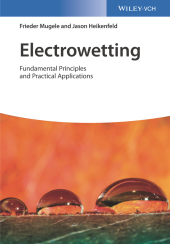 Neuerscheinungen 2019Stand: 2020-02-01 |
Schnellsuche
ISBN/Stichwort/Autor
|
Herderstraße 10
10625 Berlin
Tel.: 030 315 714 16
Fax 030 315 714 14
info@buchspektrum.de |

Jason Heikenfeld, Frieder Mugele
(Beteiligte)
Electrowetting
Fundamental Principles and Practical Applications
1. Auflage. 2019. XII, 299 S. 50 SW-Abb. 244 mm
Verlag/Jahr: WILEY-VCH 2019
ISBN: 3-527-41229-8 (3527412298)
Neue ISBN: 978-3-527-41229-7 (9783527412297)
Preis und Lieferzeit: Bitte klicken
Starting from the basic principles of wetting, electrowetting and fluid dynamics all the way up to those engineering aspects relevant for the development of specific devices, this is a comprehensive introduction and overview of the theoretical and practical aspects.
Written by two of the most knowledgeable experts in the field, the text covers both current as well as possible future applications, providing basic working principles of lab-on-a-chip devices and such optofluidic devices as adaptive lenses and optical switches. Furthermore, novel e-paper display technology, energy harvesting and supercapacitors as well as electrowetting in the nano-world are discussed. Finally, the book contains a series of exercises and questions for use in courses on microfluidics or electrowetting.
With its all-encompassing scope, this book will equally serve the growing community of students and academic and industrial researchers as both an introduction and a standard reference.
1 A prelude on wetting
1.1 Homogeneous surfaces - Young-Laplace equation & Young-Dupré equation
1.2. Wetting in external fields - gravity & electric fields (leaky dielectric model)
1.3 Nano-scale wetting: effective interface potential
1.4 Wetting of heterogeneous surfaces - c.a. hysteresis & heterogeneity; Gibbs pinning criterion; metastability; Wenzel, Cassie-Baxter eq.,
1.5 Dynamic wetting
2 From electrocapillarity to electrowetting - a historic perspective
2.1 Lippmann´s experiments; Lippmann equation in physical chemistry
2.2 Early applications (EC electrometer)
2.3 Early electrowetting (Frumkin)
3 Basic principles of modern electrowetting
3.1 Electrowetting on dielectric:
3.1.1 Derivation of EW equation
3.1.2 Effective surface tension picture
3.1.3 Origin of the minus sign
3.1.4 From Debye layer capacitance to dielectric layer: where is the energy (gain)?
3.1.5 AC vs. DC electrowetting
3.2 Microscopic picture
3.2.1 Local electric field & modified Laplace eq.
3.2.2 Consequences: diverging local fields
3.2.3 Reconciliation micro-macro
3.3 c.a. saturation: the big mystery of EW
4 Classical wetting phenomena controlled by electrowetting
4.1 Morphology transition on structured surfaces (wetting of fibers; EW of superhydrophobic surfaces)
4.2 Drop actuation by wettability gradients
4.3 Drop dynamics (oscillations, relaxation times, damped vs. overdamped)
4.4 Contact line dynamics (in air - in oil)
5 Numerical simulations of electrowetting (?)
6 Electrowetting materials
6.1 Insulators (dielectric breakdown; charge trapping; self-healing)
6.2 Liquids (small ions vs. large ions; colloidal stability; solubility (water in oil); surfactants)
7 Applications of EW
7.1 Lab-on-a-Chip devices
7.1.1 Classical device design & drop manipulation
7.1.2 Systems integration (bus architecture; programming)
7.1.3 Bio-challenges (surfactants; protein adsorption; cells)
7.1.4 Combined EW + detection (SPR, MALDI)
7.1.5 Electrowetting in two-phase flow microfluidics
7.2 Optoelectrowetting
7.2.1 Adaptive lenses
7.2.2 Autofocus systems
7.2.3 Beam stearing
7.2.4 Optical switches
7.2.5 Diffractive elements
7.2.6 Lens arrays
7.3 Electrowetting displays
7.3.1 Basics of display technology
7.3.2 The liquavista design
7.3.3 Cincinatti design
8 The future of EW
8.1 Novel applications
8.1.1 Reverse electrowetting: Energy harvesting systems
8.1.2 Reserve batteries & supercapacitor?
8.1.3 MALDI for EW
8.1.4 Reversible sponge
8.1.5 Mechanical actuators
8.2 Breaking the limits: nano EW; beyond c.a. hysteresis


